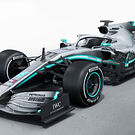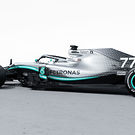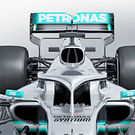Mercedes debuts all-new W10 at Silverstone

Mercedes-AMG Petronas Motorsport today completed the first laps with its 2019 challenger. Named the Mercedes-AMG F1 W10 EQ Power+, the 2019 contender ran on the 2.98 km Silverstone International Circuit this morning with Valtteri Bottas behind the wheel, to be followed by Lewis Hamilton this afternoon.
“The 2019 season will be a new challenge for all of us,” said Toto Wolff, Team Principal & CEO. “The regulations have changed quite substantially. We have to start from scratch, we need to prove ourselves again – against our own expectations and against our competitors. We start the season with zero points, so we’re taking nothing for granted and there’s absolutely no feeling of entitlement to be at the front. In fact, with the regulation change for the new season, every team can have a shot at the title and we’re seeing all of them as a potential threat.”
Today’s running constitutes an official 100 km filming day, which the team also uses as a final systems check before the first preseason test in Barcelona.
“We’re eager to hit the ground running in Barcelona, to benchmark ourselves against our own simulations and see if our predictions materialise on track,” said Toto. “We will focus on ourselves, building up performance and hopefully be ready when the first really competitive session starts on Saturday in Melbourne.”
Compared to its predecessor, the Mercedes-AMG F1 W10 EQ Power+ has been changed substantially. The majority of those modifications were driven by the significant changes to the Technical Regulations for the 2019 Formula One season.
“Regulation changes are both opportunity and threat,” said Technical Director James Allison. “They are an opportunity because all the old assumptions about what you need to have to be quick are swept away and, if you are fleet of foot and smart in dealing with that, you can do better than all the other teams that are tackling the same change. They are a threat because if you are not as smart and you didn’t see how to make the most of these new regulations, then you’ll certainly suffer in the coming season. But they are always exhilarating because you have that sharp sense of anxiety that you might not be doing enough but equally the thrill and excitement of looking forward to finding out.”
In addition to dealing with the changes to the aerodynamic regulations, which were the main focus in the development of the W10, the team worked hard to improve the weaker areas of the previous car and further build on its strengths.
“The handling of the W09 was a big improvement over the rather idiosyncratic W08,” said James. “We managed to be competitive at tracks which had plagued us in recent years. However, notwithstanding this improvement, we were still not as good as some of our competitors at preserving the performance of the rear tyres. We have worked hard on the suspension and aerodynamic characteristics to deliver a car that will be much kinder to its tyres – enough, we hope, to allow us to be competitive at all phases of the race and at each track on the calendar.
Allison added that the new Mercedes features the same philosophy and wheelbase as its predecessors as the team pushed in to reduce weight of every component, while using that freed up weight to gain a competitive edge.
“Even though the minimum weight limit was lifted by 10kg for 2019, weight reduction remains a real challenge on the current generation of F1 cars. Components that we felt were stripped to the bone in 2018 have been taken, one by one, and subjected to a further round of aggressive analysis to shave further weight from them. Some components surrender what feels like a giant step of half a kilo, others just a few grams, but collectively each of these victories add up to a handful of kilos that have been invested back in the car on aerodynamics, suspension and Power Unit to bring performance.”







